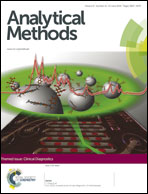Development of a direct competitive chemiluminescent ELISA for the detection of nitrofurantoin metabolite 1-amino-hydantoin in fish and honey
Abstract
A direct competitive enzyme-linked immunosorbent assay (ELISA) with chemiluminescent (dcCLELISA) detection for 1-amino-hydantoin (AHD) was developed in this study. AHD was derivatised with 4-carboxybenzaldehyde to produce 1-[(4-carbo-benzylidene)-amino]-imidazolidin-2,4-dione (CPAHD). Monoclonal antibodies (MAb) against AHD were prepared through immunization of BALB/c mice with synthesized CPAHD–Jeffamine–BSA as an antigen. Luminol, p-iodophenol, and urea peroxide mixture solution served as the substrate in CLELISA. The specificity of the MAb, estimated as the cross-reactivity values from the dcCLEILISA assay for 1-[(4-nitro-benzylidene)-amino]-imidazolidin-2,4-dione (NPAHD) and CPAHD, was 100% and 39.67%, respectively. All other compounds showed less than 0.01%. The sensitivity of the antibody, estimated as the IC50 value, was 0.60 μg L−1. The limits of detection for dcCLELISA in fish and honey samples were 0.1 and 0.28 μg kg−1, respectively, and the mean recovery values ranged from 83.6% to 94.7% for fortified samples at levels of 0.25–10 μg kg−1 with coefficient of variation values below 15%. Finally, dcCLELISA was compared to a commercial kit in the detection of AHD in spiked fish and honey samples. The immunoassay method described here showed a broad detection range and high sensitivity. It could be used for high-throughput monitoring of AHD in fish and honey samples and possibly other types of food.


 Please wait while we load your content...
Please wait while we load your content...